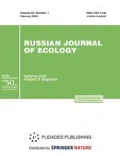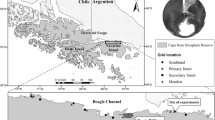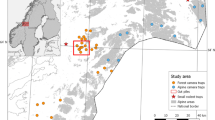Abstract
Prey-predator relationships can affect habitat selection of the animals greatly. In the recent investigation we tried to test how rodents can affect nocturnal sand cat habitat usage pattern. Microhabitat affinities of sand cat and its den site selection were investigated in Sistan and Baluchistan Province from early 2013 to late 2015 in Semsor area. The data acquired from 29 presence plots of individuals were compared by paired non-used plots; the results indicated that the presence of Haloxylon ammodendron and relative density of rodents mainly affected Sand cat microhabitat selection. We also found that the species den site selection was mainly influenced by the presence of tall shrubs such as Haloxylon ammodendron and Tamarix sp. We concluded that the habitat selection pattern of sand cat in the study area could be significantly influenced by rodents’ microhabitat selection; however, such relationship may not be true in larger spatial scales like species home range.
Similar content being viewed by others
References
Cunningham, P., Status of the Sand Cat, Felis margarita, in the United Arab Emirates, Zool. Middle East, 2002, vol. 25, no. 1, pp. 9–14.
Ghafaripour, S., Naderi, M., and Rezaei, H.R., Investigating abundance, density and potential threats of Sand cat in the South-Eastern parts of Iran. J. Wildl. Biodivers., 2017, vol. 1, no. 1, pp. 47–55
Schauenberg, P., Données nouvelles sur le chat des sables Felis margarita Loche, 1858, Suisse Zool., 1974, vol. 48, pp. 949–969.
Hemmer, H., Gestation period and postnatal development in felids, in The World’s Cats, Eaton, R.L., Ed., Seattle, WA: Carnivore Research Institute, Univ. of Washington, 1976, pp. 143–165.
Gasperetti, J., Harrison, D.L., and Biittiker W, The Carnivora of Arabia, Fauna of Saudi Arabia, 1986, vol. 7, pp. 397–461.
Harrison, D.L., and Bates, P.J.J., The Mammals of Arabia, 2nd ed., Sevenoaks, UK: Harrison Zoological Museum, 1991.
Abbadi, M., Israel’s elusive feline: Sand cats, Cat News, 1992, vol. 18, pp. 15–16.
Dragesco-Joffe, A., Le chat des sables, un redoutable chasseur de serpents, in La Vie Sauvage du Sahara, Lausanne, Switzerland: Delachaux et Niestlé, 1993, pp. 129–133.
Heptner, V.H. and Sludskii, A.A., Mammals of the Soviet Union, vol. 3: Carnivores (Feloidea), English Transl., Hoffmann, R.S., Ed., Washington, DC: Smithsonian Inst., Natl. Science Foundation, 1992.
Happold, D.C.D., Small mammals, in Key Environments: Sahara Desert, Cloudsley-Thompson, J.L., Ed., London: Pergamon, 1984, pp. 251–275.
Goodman, S.M, and Helmy, I., The sand cat Felis margarita Loche, 1858 in Egypt, Mammalia, 1986, vol. 50, pp. 120–1231.
Russell Cole, F., and Wilson, D.E., Felis margarita (Carnivora: Felidae), Mammal. Species, 2015, vol. 47, no. 924, pp. 63–77
Hemami, M.R., Naderi, G.H., Karami, M., and Mohammadi, S., Nocturnal activity of Iranian Jerboa Allactaga firouzi (Mammalia: Rodentia: Dipodidae), Mammalia, 2011, vol. 75, pp. 42–57
Darabi, M., Zeini, Z., Karimi, A. and Kaveh, A., Nocturnal activity and habitat selection of Hotson Jerboa, Allactaga hotsoni Thomas, 1920 (Rodentia: Dipodidae). J. Wildl. Biodivers., 2017, vol. 1, no. 1, pp. 33–36.
Postanowicz, R., Sand cat (Felis margarita). https://doi.org/www.lioncrusher.com/animal.asp?animal=67r.com/animal.asp?animal=67
De Smet, K., The distribution and habitat choice of larger mammals in Algeria, with special reference to nature protection. Ph.D. Thesis, University of Ghent, 1989
Ferrero, D.M., Lemon, J.K., Fluegge, D., Pashkovski, S.L., Korzan, W.J., Datta, S.R., et al., Detection and avoidance of a carnivore odor by prey, Proc. Natl. Acad. Sci. U. S. A., 2011, vol. 108, pp. 11235–11240.
Stephens, D.W., and Charnov, E.L., Optimal foraging: Some simple stochastic models, Behav. Ecol. Sociobiol., 1982, vol. 10, pp. 251–263.
Stephens, D.W., and Krebs J.R., Foraging Theory, Princeton, NJ: Princeton Univ. Press, 1986.
Naderi, G.H., Hemami, M.H., Riazi, B., and Alesheikh, A., Notes on ecological peculiarities of Allactaga firouzi Womochel, 1978 (Mammalia: Dipodidae), Zool. Middle East, 2009, vol.47, pp. 21–28.
Krebs, C. J., Ecological Methodology, 2nd ed., Melo Park, CA: Addison–Wesley, 1999.
Naderi, G.H., Mohammadi, S., Imani, A., and Karami, M., Habitat selection and burrow structure of Blanford’s Jerboa, Jaculus blanfordi (Mammalia: Rodentia) from Central Desert of Iran, Acta Zool. Bulg., 2014, vol. 66, no. 2, 225–228.
Naderi, G.H, Hemami, M., Riazi, B., Alesheikh, A., Iranian Jerboa abundance and habitat selection, Ph.D. Thesis, Tehran, Iran: Islamic Azad University, Science and Research Branch, 2009.
Ghafaripour S., Naderi, M., Riazi, B. and Rezaei, H.R., Ecology and biology of sand cat in Sistan and Baluchistan Province, Ph.D. Thesis, Tehran, Iran: Islamic Azad University, Science and Research Branch, 2016.
Murray, G.B., and Vestal, B.M., Effects of environmental structure on the burrow distribution of thirteen-lined ground squirrels, Spermophilus tridecemlineatus (Sciuridae), Southwest. Nat., 1979, vol. 24, no. 1, pp. 79–86.
Laundre, J.W., and Appel, N.K., Habitat preferences for burrow sites of Richardson’s ground squirrels in southwestern Minnesota, Prairie Nat., 1986, vol. 18, no. 4, pp. 235–239.
Naderi, Gh., Hemami, M.R., Mohammadi, S., Riazi, B., Karami, M., Kaboli, M., Alesheikh, A., Effects of vegetation and soil conditions on burrow structure and site ion of rare desert rodent Iranian jerboa (Allactaga firouzi), Pol. J. Ecol., 2011, vol. 59, no. 2, pp. 403–410.
Bearhop, S., Hilton, G.M., Votier, S.C., and Waldron, S., Stable isotope ratios indicate that body condition in migrating passerines is influenced by winter habitat, Proc. R. Soc. Lond. B: Biol. Sci., 2004, vol. 271, no. 4, pp. 215–218.
Norris, D.R., Marra, P.P., Kyser, T.K., and Sherry, T.W., Tropical winter habitat limits reproductive success on the temperate breeding grounds in a migratory bird, Proc. R. Soc. Lond. B: Biol. Sci., 2004, vol. 271, pp. 59–64.
Gunnarsson, T.G., Gill, J.A., Newton, J., Potts, P.M., and Sutherland, W.J., Seasonal etching of habitat quality and fitness in a migratory bird. Proc. R. Soc. Lond. B: Biol. Sci., 2005, vol. 272, pp. 2319–2323.
Charnov, E.L., Optimal foraging, the marginal value theorem, Theor. Popul. Biol., 1976, vol. 9, pp. 129–136.
Fortin, D., Fryxell, J.M., O’Brodovich, L., and Frandsen, D., Foraging ecology of bison at the landscape and plant community levels: The applicability of energy maximization principles, Oecologia, 2003, vol. 134, pp. 219–227.
Comins, H.N., and Hassell, M.P., The dynamics of optimally foraging predators and parasitoids, J. Anim. Ecol., 1979, vol. 48, pp. 335–351.
Pyke, G.H., Optimal foraging theory: A critical review, Annu. Rev. Ecol. Syst., 1984, vol. 15, pp. 523–575.
Ropert-Coudert, Y., Kato, A., Wilson, R.P., and Cannell, B., Foraging strategies and prey encounter rate of free-ranging little penguins, Mar. Biol., 2006, vol. 149, pp. 139–148.
Martínez, J.A., Serrano, D. and Zuberogoitia, I., Predictive models of habitat preferences for the Eurasian eagle owl Bubo bubo: A multiscale approach, Ecography, 2003, vol. 26, pp. 21–28.
Ciarniello, L.M., Boyce, M.S., Seip, D.R. and Heard, D.C., Grizzly bear habitat selection is scale dependent, Ecol. Appl., 2007, vol. 17, pp. 1424–1440.
Mayor, S.J., Schaefer, J.A., Schneider, D.C., and Mahoney, S.P., Spectrum of selection: New approaches to detecting the scale-dependent response to habitat, Ecology, 2007, vol. 88, pp. 1634–1640.
Glaudas X. and Rodríguez-Robles J.A., A two-level problem: Habitat selection in relation to prey abundance in an ambush predator, the speckled rattlesnake (Crotalus mitchellii), Behavior, 2011, vol. 148, pp.1491–1524.
Murúa R and González LA., Microhabitat selection in two Chilean cricetid rodents, Oecologia, 1982, vol. 52, pp. 12–15.
Dalmagro, A.D., and Vieira, E.M., Patterns of habitat utilization of small rodents in an area of Araucaria forest in Southern Brazil, Austral. Ecol., 2005, vol. 30, pp. 353–362.
Author information
Authors and Affiliations
Corresponding author
Additional information
The article is published in the original.
Rights and permissions
About this article
Cite this article
Ghafaripour, S., Naderi, M., Riazi, B. et al. How Prey Density and Distribution Can Affect Predator Habitat Usage Pattern: a Case Study on Sand Cat (Felis margarita, Locke 1858) from Iran. Russ J Ecol 49, 320–324 (2018). https://doi.org/10.1134/S1067413618040057
Received:
Published:
Issue Date:
DOI: https://doi.org/10.1134/S1067413618040057




